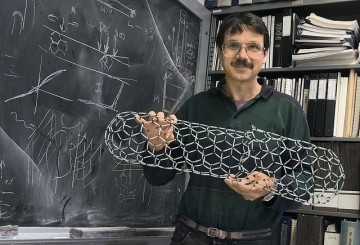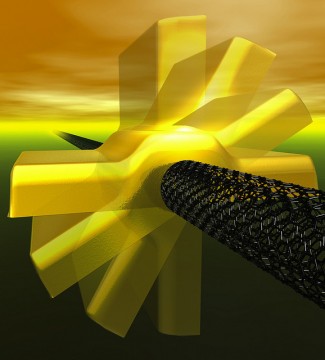Alex Zettl with nanotube model - 1997
Alex Zettl with nanotube model - 1997
credit: Lawrence Berkeley Nat'l Lab - Roy Kaltschmidt, photographer
World's Smallest Nanomotor
This simulation shows a nanomotor built of gold paddle-shaped rotor blades spinning on a multi-walled carbon nanotube. The motor, developed by Lab researcher Alex Zettl and his colleagues, is about 300 times smaller than the diameter of a human hair, and the technology behind it allows for future versions to be made even smaller – perhaps as much as five times smaller.The synthetic rotational nanomotor has been clocked at 33,000 cycles per second and is believed to be capable of speeds approaching one billion rotations per second. Because the carbon and carbon bonds connecting the rotor blade to the shaft are practically frictionless, the motor can run indefinitely without wearing down. It is also rugged enough to withstand the harshest of environmental conditions, including extreme temperatures and radiation. Some of the potential applications of the nanomotor technology include bio and environmental sensors, cell phones, PDAs, optics, airbags, tire sensors, digital pens and blood pressure monitors. The technology should also find a broad range of applications in the field of cosmology for the exploration of deep space.credit: Lawrence Berkeley Nat'l Lab


